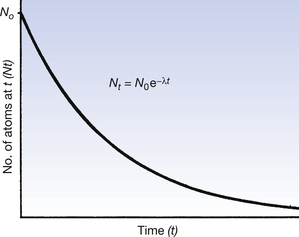Harry is working in a restaurant. He has to make a pot of soup every night for the next day. His problem: How long to wait for the boiling soup to cool down to room temperature? Because he has to put the soup in the fridge before closing the shop. He can speed up the cooling process by placing the closed soup pot under flowing cool tap water.
He knows one fact; it takes 10 minutes to cool down to 60 degree from 100 degree. If he knows "rate of cooling", he can easily calculate the time the soup will take to reach room temperature. Here, an important and universal formula comes to our help.
T = T0*eˆ(-Rt}
T - Temperature at the moment = 60 degree
T0 - Initial temperature = 100 degree
e - Euler's constant = 2.71...
R - Rate of cooling - to find
t - elapsed time -10 minutes.
By pluging in all the values, we get rate of cooling R as 0.051 degree/minute
Now, we can find out the time taken to reach the room temperature.
Again use T = T0* eˆ(-Rt)
say, room temperature is 25; t =?
we get t as 27.18 minutes
Hence, Harry has to wait nearly half-an-hour -27 minutes for the soup to touch 25 degree. So that he can safely put the soup in the refrigerator and go home.
This example is given to illustrate the use of that formula. This formula appears everywhere where natural growth and decay arises.
The examples
1. Population growth
2. Rise and fall current in the capacitor and inductor.
3. Water flow from a tank.
4. Growth of money in a bank.
5. Radioactivity.
The formula involves, the constant e which govern the natural growth and decay. For growth, + sign appear in the power of e. And negative sign for decay.
In a growth, the increase is slow initially, rapid later. And it is opposite in the decay. .
The formula also tells that the growth or decay is proportional to the amount of entity present at the given moment. For example 1. Higher the temperature, the rapid the fall. 2. Lower the pressure, less the water folw. 3. Higher the amount of money, sooner it grows.
This formula is yet another key which unlocks the nature.
-------------------------------------------------------------------------------------------------
for the advanced,
R calculation
60 = 100eˆR10
60 = 100eˆ-10R
60/100 = eˆ-10R
100/60 = eˆ10R
eˆ10R =1.67
Log (eˆ10R) = Log 1.67(natural log base e)
10R = Log 1.67
R = Log 1.67/10 = 0.051 degree/minute
t calculation
25 = 100 eˆ-0.051*t
25/100 = e ˆ-0.051t
100/25 = e ˆ0.051t
eˆ0.051t = 100/25 =4
Log (eˆ0.051t) = Log 4
0.051t = Log 4
t = Log 4 / 0.051 = 27.18 minutes.
